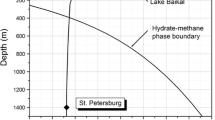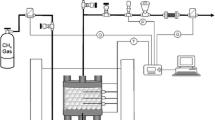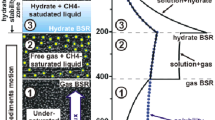Abstract
During the Russian Academy of Sciences “MIRI na Baikale. 2008–2009” expedition, deep-water experiments on methane bubbles emerging from the lake bottom at depth of 1400 and 860 meters were carried out. Bubbles escaping the seabed were caught by a trap, which was an inverted glass. Entering in the trap, bubbles became covered by a gas hydrate envelope and then after a time period collapsed into a number of gas hydrate solid fragments. Due to positive buoyancy, fragments remained in the top part of a trap, exhibiting properties of a powder. The glass’s bottom was replaced with a 1 mm mesh grid, allowing the finest gas hydrate particles to sift through the grid, rising upwards. It is proposed that bubble collapse into fragments is related to the pressure drop in the bubble in the course of formation of the gas hydrate envelope. No visible changes in the gas hydrate powder were observed in the course of lifting it to a depth of 380 meters. Shallower than 380 meters, i.e., outside the zone of gas hydrate stability, decomposition of the gas hydrate powder into methane gas was observed.
Similar content being viewed by others
References
G. D. Ginsburg and V. A. Solov’ev, Submarine Gas Hydrates (VNIIOkeanologiya, St. Petersburg, 1994) [in Russian].
A. V. Egorov, E. S. Chernyaev, A. N. Rozhkov, and N. A. Rimskii-Korsakov, “Gas Hydrate Hills at the Bottom of Lake Baikal” (www.ocean.ru/content/view/810/41).
V. P. Epifanov, “Ice-like breakup Mechanics Depending on Temperature and Load Rate,” Izv. Akad. Nauk, Mekhan. Tverd. Tela, No. 2, 188–196 (1984).
T. S. Kollett, R. L’yuis, and T. Uchida, “Growing Interest to Gas Hydrates,” Neftegaz. Obozren. 6(2), 38–53 (2001).
L. D. Landau and E. M. Lifshits, Theoretical Physics, Vol. 7: Theory of Elasticity (Nauka, Moscow, 1987) [in Russian].
R. I. Nigmatulin, Dynamics of Multiphase Media (Nauka, Moscow, 1987), Vol. 2 [in Russian].
A. N. Rozhkov, “Dynamics and Destruction of Viscoelastic Liquids (Review),” Izv. Ross. Akad. Nauk, Mekh. Zhidk. Gaza, No. 6, 3–24 (2005).
S. P. Timoshenko and J. Goodyear, “Theory of Elasticity,” (Nauka, Moscow, 1979) [in Russian].
O. M. Khlystov, A. G. Gorshkov, A. V. Egorov, et al., “Oil in the Lake of World Heritage,” Dokl. Akad. Nauk 414(5), 1–4 (2007) [Dokl. 414 (5), 682–687 (2007)].
O. M. Khlystov, T. I. Zemskaya, T. Ya. Sitnikova, et al., “Bottom Bituminous Constructions and Biota Inhabiting Them according to Investigation of Lake Baikal with the Mir Submersible,” Dokl. Akad. Nauk 428(5), 682–685 (2009).
A. V. Egorov, K. Crane, P. R. Vogt, and A. N. Rozhkov, “Gas Hydrates That Outcrop on the Sea Floor: Stability Models,” Geo-Marine Lett. 18, 68–75 (1999).
J. Greinert, Y. Artemov, V. Egorov, et al., “1300-M-High Rising Bubbles from Mud Volcanoes at 2080 m in the Black Sea: Hydroacoustic Characteristics and Temporal Variability,” Earth Planetary Science Lett. 244, 1–15 (2006).
K. U. Heeschen, R. W. Collier, M. A. De Angelis, et al., “Methane Sources, Distributions, and Fluxes from Cold Vent Sites at Hydrate Ridge, Cascadia Margin,” Global Biogeochemical Cycles 19, 1–19 (2005).
I. Leifer and A. G. Judd, “Oceanic Methane Layers: The Hydrocarbon Seep Bubble Deposition Hypothesis,” Terra Nova 14, 417–424 (2002).
I. Leifer and I.R. MacDonald, “Dynamics of the Gas Flux from Shallow Gas Hydrate Deposits: Interaction between Oily Hydrate Bubbles and the Oceanic Environment,” Earth Planetary Science Lett. 210, 411–424 (2003).
I. Leifer and R. K. Patro, “The Bubble Mechanism for Methane Transport from the Shallow Sea Bed to the Surface: A Review and Sensitivity Study,” Continental Shelf Res. 22, 2409–2428 (2002).
I.R. MacDonald, I. Leifer, R. Sassen, et al. Transfer of Hydrocarbons from Natural Seeps to the Water Column and Atmosphere, Geofluids 2, 95–107 (2002).
Author information
Authors and Affiliations
Corresponding author
Additional information
Original Russian Text © A.V. Egorov, R.I. Nigmatulin, N.A. Rimskii-Korsakov, A.N. Rozhkov, A.M. Sagalevich, E.S. Chernyaev, 2010, published in Okeanologiya, 2010, Vol. 50, No. 4, pp. 505–514
Rights and permissions
About this article
Cite this article
Egorov, A.V., Nigmatulin, R.I., Rimskii-Korsakov, N.A. et al. Breakup of deep-water methane bubbles. Oceanology 50, 469–478 (2010). https://doi.org/10.1134/S000143701004003X
Received:
Accepted:
Published:
Issue Date:
DOI: https://doi.org/10.1134/S000143701004003X




